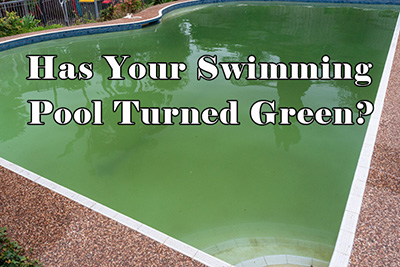Has Your Pool Turned Green? Here's Why
Tue, Jun 23rd, 2020
It's a beautiful Saturday morning and you're about to go for a swim, but to your unpleasant surprise, the pool water has turned green! What does this mean and how did this happen?
We've received many calls over the years from people saying that their pool water has turned green. Sometimes it can seemingly happen overnight. In some cases, it does. When it's warm outside, the algae will bloom significantly faster than in cooler climates. But we're more likely to discover that the cause of this algae growth has been an ongoing issue due to a chemical imbalance in the pool.
Not Enough Chlorine? Your Pool Might Turn Green
Did you know, the shade of green can determine how much algae is present? If your pool has a light green shade to it, that's a good sign and you caught the issue before it progressed very far, which will make it easier to reverse.
A very likely reason for a chemical imbalance in your pool is that chlorine levels are too low. When there isn't enough chlorine in your pool, algae easily floats and attaches to pool walls and floor.
What Else can Cause Algae to Grow?
Several other reasons can result in pool water turning green:
- Pool pumps and filters that are too small.
- The filter isn't running long enough every night (8 hours).
- The cartridge filter isn't being cleaned enough.
- Exposure to oxidized copper (RARE).
Exposure to oxidized copper is a very rare occurrence and can only happen if your pool comes into contact with copper (pool heater corrosion).
Need Your Pool Blue Again in a Hurry? Shock it
In most circumstances, the fastest way to make your pool water blue gain is to shock it... or the technical term is super-chlorination. This is the process of adding chemicals to eliminate the build-up of algae, bacteria and other organic particulates.
- First, make sure to test the pool's water chemistry and make sure the pool is clean and rid of leaves.
- Next, make sure the pool is filled to its regular level.
- Check the pH level and make sure it's between 7.2 and 7.6 (lower level is best to avoid cloudy water).
- Determine if liquid chlorine or granular shock is best (pools with cartridge or sand filters use liquid and pools with Diatomaceous Earth filters use granular shock).
- Calculate the amount of chemicals needed. Generally best to use one or two pounds of shock for every 10,000 gallons of water. (Check the package for preparation steps).
- Once you've poured the shock mixture evenly around your pool, run the filtration pump for at least 24 hours to clear contaminants. In some cases, it might take several days.
*ALWAYS WAIT 24 HOURS AFTER SHOCKING YOUR POOL TO SWIM
Sweetwater Pool Service
Regular pool maintenance is always the best course of action to prevent any sort of problem with your swimming pool and it's equipment. But if something does happen where your pool appears to be turning green, immediately call a pool professional like Sweetwater Pool Service! We can restore that beautiful, crisp blue color to your pool water!
(239) 775-POOL (7665)



